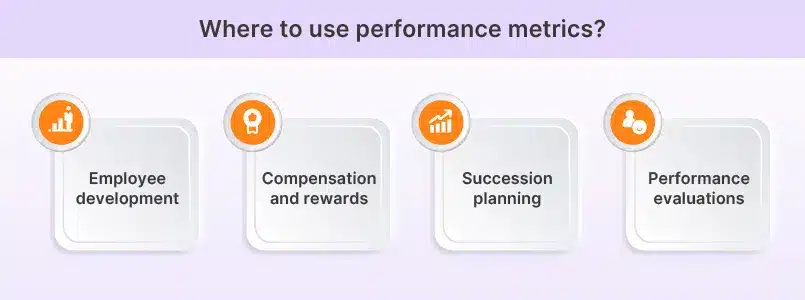Understanding and measuring employee performance isn’t just important—it’s the key to building a high-performing, engaged, and thriving workforce. But how do you track performance effectively?.
✅ Are your employees productive?
✅ Is their work meeting quality standards?
✅ Are they contributing to business growth?
In this blog post, we will delve into 20 key employee performance metrics that every organization should track. From traditional key performance indicators (KPIs) to innovative employee performance matrices, these metrics will empower you to make informed decisions that drive growth and engagement.
Key Takeaways
- Monitoring key employee performance metrics such as productivity, work quality, and customer satisfaction is essential for informed decision-making and driving organizational performance.
- Successful implementation involves setting clear goals, regularly communicating expectations, collecting and analyzing data, and providing constructive feedback and support.
- Leverage tools like Peoplebox.ai for streamlined performance tracking, goal alignment, and data-driven insights to enhance employee engagement and efficiency.

What are Employee Performance Metrics?
Employee performance metrics are data-driven indicators that measure how well employees are performing their duties over a specific period. These metrics help assess productivity, efficiency, and overall contribution to business success.

The benefits of having clearly defined performance metrics include:
- Setting measurable expectations for employees
- Keeping track of progress and identifying patterns
- Offering objective feedback on performance goals
- Making informed choices about promotions, compensations, or development opportunities
- Building a culture of responsibility and continuous growth
Organizational performance metrics offer a data-backed approach for managing staff performances and remove subjectivity from assessments to make them bias-free. They make it possible for managers to engage their teams constructively, with evidence that speaks of their strengths and weaknesses.
Why Should You Measure Employee Performance Metrics?
Measuring the employee’s performance is essential for optimizing workforce efficiency and driving business success. The following are key reasons:
1. Increasing productiveness
You can monitor output measurements and compare them with industry or company-wide benchmarks to determine who among your staff performs the best. This raises overall employee productivity and encourages a high-performance culture.
2. Identifying training needs
You can use these metrics to identify gaps in skills or areas where your employees are lacking and offer targeted training to help them get better.
3. Recognizing and rewarding high performers
Objective performance data enables you to identify and acknowledge employees who consistently exceed expectations. This, in turn, elevates morale, retention, and motivation within the company’s workforce.
4. Aligning individual performance with organizational goals
By matching company objectives to individual performance targets, you can help employees gain a clear understanding of how their work contributes to the bigger picture. This alignment ensures that everyone is working towards common goals.
5. Improving employee engagement and retention
Regular performance discussions based on measurable metrics help employees feel valued and supported in their development. This fosters a strong sense of engagement and loyalty, leading to higher retention rates as well as reduced turnover costs.
Key Employee Performance Metrics to Track
Now that we’ve explored the benefits of tracking HR metrics, let’s examine the essential metrics you should be tracking.
1. Productivity Rate
What it measures
Productivity Rate measures how efficiently an employee converts inputs (such as time, resources, or effort) into outputs (like completed tasks, products, or services).
How it helps
This metric helps you assess how well employees are utilizing their resources and time. It can highlight top performers and identify those who might need additional support or training to improve their efficiency.
By tracking productivity rate over time, you can spot trends, measure the impact of process improvements, and make data-driven decisions to boost overall team performance.
Formula to calculate it:
Productivity Rate = (Total Output / Total Input) x 100
2. Quality of Work
What it measures
This measures how accurately and precisely employees deliver.
How it helps
A small percentage means higher quality work. The metric is designed to identify those who produce very good results and those who require further training or assistance to enhance their output.
By keeping a close eye on the quality of work, you can maintain higher standards and consistently meet customer needs.
Formula to calculate it
Quality of Work = (Number of Errors / Total Output) x 100
3. Attendance Rate
What it measures
This measures an employee’s reliability and dedication.
How it helps
This helps you keep track of attendance patterns to establish if absenteeism issues exist. Cases where workers cannot regularly report to work could signal a bigger issue, like a toxic work environment, or intentions of leaving.
Formula to calculate it
Attendance Rate = (Number of Days Present / Total Working Days) x 100
4. Punctuality
What it measures
This measures how often employees get to their workplace in good time.
How it helps
When a person arrives late all the time, the team finds it difficult to function well together, decreasing overall productivity. Punctuality metrics help you address issues related to time management and help create awareness among other people about respecting one another’s time.
Formula to calculate it
Punctuality = (Number of Days Arriving on Time / Total Working Days) x 100
5. Goal Achievement
What it measures
This measures an employee’s ability to meet set objectives within a specified timeframe.
How it helps
A high percentage means that an employee knows what they want and feels highly motivated toward their goals. It recognizes top performers who consistently meet or exceed expectations.
It also helps you provide specific feedback and support for employees struggling to attain their goals.
Formula to calculate it
Goal Achievement = (Number of Goals Achieved / Total Goals Set) x 100
6. Customer Satisfaction Score
What it measures
This measures the degree of happiness with an employee’s service or interaction by the clients themselves.
How it helps
This makes it easy to identify employees who help enhance the customer service, so you can place them in more customer-facing roles. A high customer satisfaction score indicates that an employee has been able to tackle customer needs appropriately, solve problems, and maintain a good rapport with their clients.
By monitoring this particular metric, you can enhance customer loyalty and retention.
Formula to calculate it
Customer Satisfaction Score = (Sum of All Scores / Number of Respondents)
7. Sales Targets Met
What it measures
This measures if employees can reach sales quotas set for them or beyond.
How it helps
This can guide you with where additional training, coaching, or resources are needed so that poor-performing sales agents may reverse the trend and become better sellers.
When targets are monitored, you can judge whether you’re on track with meeting your revenue objectives as well.
Formula to calculate it:
Sales Targets Met = (Actual Sales / Target Sales) x 100
8. Turnaround Time
What it measures
This is a measure of how fast and effectively an employee completes tasks assigned to them.
How it helps
When an employee takes less time to complete assignments, it means that they are productive and able to utilize their time well. This is crucial for jobs that require delivering work to clients or colleagues within given timelines. Turnaround time monitoring unearths process bottlenecks and ensures employees are working efficiently.
Formula to calculate it:
Turnaround Time = (Sum of Completion Times /Number of Tasks or Projects)
9. Employee Engagement Index
What it measures
It measures the extent to which employees feel connected to their work and the organization.
How it helps
A high engagement index implies that employees are motivated and dedicated, which leads to increased productivity and retention. This metric helps you identify factors that contribute to employee engagement so you can take steps to replicate a positive work environment.
Formula to calculate it:
Employee Engagement Index = (Number of Engaged Employees / Total Employees) x 100
10. Feedback Responsiveness
What it measures
This metric assesses an employee’s ability to accept and respond to feedback within a short period.
How it helps
A high percentage demonstrates an employee’s desire to learn, grow, and absorb constructive criticisms. The metric encourages free communication, creates a culture of growth, and helps you recognize those who are more receptive and willing to work on themselves.
Formula to calculate it
Feedback Responsiveness = (Number of Feedback Responses within Timeframe / Total Feedback Received) x 100
11. Training Effectiveness
What it measures
A way of measuring how well training programs improve job performance.
How it helps
A higher percentage indicates that the training you provide is useful in enhancing the skills and knowledge required for the job. This way, you can evaluate the ROI of training initiatives, identify the most successful training methods, and make data-based decisions about future investments in training.
Formula to calculate it:
Training Effectiveness = [(Post-Training Performance – Pre-Training Performance) / Pre-Training Performance] x 100
12. Innovation Index
What it measures
It refers to an employee’s ability to introduce novel concepts that will assist the organization in growing or improving itself.
How it helps
A high innovation index shows a culture that appreciates creativity, openness to experimentation, and recognition for driving positive improvements among employees.
Use this measure to identify those people who have brought new ideas or solutions to foster continuous performance improvement.
Formula to calculate it:
Innovation Index = (Sum of Implemented Innovative Ideas / Number of Employees)
13. Error Rate
What it measures
This measures how many times one makes mistakes when working.
How it helps
A lower error rate implies attention to detail, a sense of accuracy, and quality commitment at work. By tracking error rates, you can identify areas where additional training may be necessary.
In fields such as healthcare or finance, such metrics are very significant due to the consequences of errors.
Formula to calculate it:
Error Rate = (Number of Errors / Total Operations) x 100
14. Work Ethic Score
What it measures
It is an indicator of how well an employee’s values align with those of his/her organization.
How it helps
High work ethic scores imply that an employee consistently conducts themselves with integrity, and shows professionalism and devotion to job duties.
It helps build a culture of responsibility where employees are accountable for upholding the reputation of the company and maintaining trust among stakeholders. You can also use it to identify and address any conduct that might conflict with organizational values.
Formula to calculate it:
Work Ethic Score = Sum of Ratings / Number of Categories Assessed
15. Team Collaboration Index
What it measures
This indicates how well a team cooperates, communicates, and mutually supports each other.
How it helps
A high collaboration index signifies that a team utilizes the strengths of each member to achieve common goals. Organizations use this metric to identify teams that function well jointly and those that have room for improvement in their collaboration skills.
Formula to calculate it
Team Collaboration Index = (Sum of Collaboration Ratings divided by the Number of Team Members)
16. Adaptability Score
What it measures
This measures an employee’s adaptability for new situations, challenges, or tasks.
How it helps
A higher adaptability score denotes an employee who is flexible, resilient, and can thrive in a dynamic environment. You may use this performance measurement to identify staff who can facilitate change while supporting others through it.
Formula to calculate it:
Adaptability Score = (Sum of Adaptability Ratings divided by the Number of Categories Assessed)
17. Project Success Rate
What it measures
This estimates what percentage of an employee’s projects meet or surpass predefined success criteria such as scheduled completion, budget adherence, and stakeholder satisfaction.
How it helps
A high project success rate reveals those who are consistently performing well and contributing to the general accomplishments of the organization.
Use this approach to evaluate efficiency levels as to how projects are managed internally, helping you make resource assignment decisions.
Formula to calculate it
Project Success Rate = (Number of Successful Projects/Total Projects Completed) multiplied by 100
18. Cost Efficiency
What it measures
This measures the output generated per dollar spent by an employee on generating revenue or output while minimizing costs.
How it helps
This criterion is key to roles whose influence on a company’s bottom line is direct such as sales or operations departments. Monitoring cost efficiency helps you identify opportunities for process improvements, cost savings, and increased profitability.
Formula to calculate it:
Cost Efficiency = (Revenue Generated/Cost Incurred x 100)
19. Customer Retention Rate
What it measures
This estimates what percentage of customers an employee has managed to retain over a given period compared with the total number they were serving at the start of that period.
How it helps
A high customer retention rate suggests that an employee offers excellent service, builds trust and loyalty, and addresses customer needs in advance.
For positions involving customer interaction, this metric becomes a vital tool for evaluating customer retention strategies.
Formula to calculate it:
Customer Retention Rate = (Number of Customers Retained/Total Customers at Start of Period) multiplied by 100
20. Time Management Efficiency
What it measures
It measures an employee’s skill to arrange their time well to complete assignments within the set deadlines.
How it helps
Almost 100% means that an employee estimates time for tasks correctly and handles his or her work effectively. This indicator helps to identify employees who are highly organized and productive and those who may require assistance in enhancing their time management abilities.
Monitor this metric to ensure workers make good use of their working hours and contribute towards improving the overall efficiency of an organization.
Formula to calculate it:
Time Management Efficiency = Planned Time / Actual Time Spent x 100
Implementing Performance Metrics in Your Organization
To implement performance metrics for an organization, you need to have a well-thought-out and executed plan. Here are some practical steps you can consider:
Define Clear Performance Expectations
- Align goals: Clearly articulate organizational objectives and cascade them into specific, measurable individual goals for each role, a.k.a OKRs. Setting up goals in a breeze with Peoplebox.ai. Try it yourself!
- Open communication: Ensure employees understand expectations, how their performance will be evaluated, and the impact of their work on overall success.
Foster a Culture of Performance
- Regular feedback: Implement regular check-ins and performance discussions to provide timely feedback and coaching.
- Transparent communication: Maintain open dialogue about performance expectations, achievements, and areas for improvement.
- Employee engagement: Encourage employee input in goal-setting and performance evaluation to foster ownership and buy-in.
Measure and Analyze Performance
- Data-driven insights: Establish a system for collecting and analyzing performance data to identify trends, strengths, and areas for development.
- Actionable insights: Transform data into actionable insights through clear visualizations and reports.
Develop and Support Employees
- Growth opportunities: Create individualized development plans to help employees enhance their skills and capabilities.
- Resource allocation: Provide necessary resources, such as training, mentorship, or coaching, to support employee growth.
- Recognition and rewards: Celebrate achievements to motivate and inspire employees.
Adapt and Improve
- Continuous evaluation: Assess the effectiveness of performance metrics on a regular basis and adjust them as needed to align with organizational changes.
- Employee involvement: Involve employees in the review process to ensure metrics remain relevant and achievable.
By following these steps and maintaining a focus on employee development and organizational success, you can create a high-impact performance management system that drives results.
Incorporating Performance Metrics into Talent Management
Employee performance metrics are useful indicators that inform an organization’s talent management strategies. Here’s how to use performance metrics:

Employee development
Use the data collected on employee performance to identify gaps in skills either at an individual or group level. Design specific training programs that meet these needs, and help workers acquire knowledge and expertise for their job roles.
Evaluate how skill acquisition influences output to make data-driven decisions about future expenditure.
Compensation and rewards
Connect the dots between performance data with compensation and rewards so that there is a clear link between what individuals do as well as the company’s success. Revise remuneration decisions such as merit increases, and bonuses, if someone is attributing to increased revenue. Ensure that your awards are equitable and consistent.
Succession planning
Create training and development programs aimed at preparing potential leaders identified through key indicators. Regularly review existing succession plans based on evolving metrics like an employee’s work rate over time.
Performance evaluations
Find areas of high performance using performance data and talk about their strengths, weaknesses, and objectives for future improvement. Confirm that the employee appraisals are regular, prompt, and parallel to the company’s performance management system.

Track Employee Performance with Peoplebox.ai
Peoplebox.ai is a powerful performance management software that can help you develop business strategies. With Peoplebox.ai, you can easily monitor employee performance monitoring and analyze it.
Here’s how Peoplebox.ai helps you evaluate employee performance:
✅ OKRs: Connects employee goals with business objectives for clarity and focus.
✅ Performance Reviews: Simplifies the review process to track progress and provide feedback easily.
✅ People Analytics: Provides insights into workforce metrics for informed decision-making.
✅ Engagement Surveys: Measures employee engagement and identifies areas for improvement.
✅ Integrations: Connects with existing HR tools for seamless data synchronization. Ready to build a thriving workforce? Get in touch with us today!







